Lucid Air Review: You're going to get lots of questions. Here are the answers

Pros: BIG power; incredible range, efficiency and charging speeds; spacious, functional and high-tech interior
Cons: It ain’t cheap; software glitches; questionable reliability as first-time carmaker
If you’re the type of person who loves talking about the state-of-the-art (blank) you just brought home, who eagerly answers questions like, “That’s so cool, what is it?” and the stream of inevitable follow-ups, boy are you going to love the Lucid Air. Not only will its classy, futuristic exterior draw attention everywhere you go, but there’s so much about this revolutionary electric car that’s cool, different, game-changing and just plain-old special that you’re bound to have more answers than questions. Indeed, there was too much to share in our Lucid Air first drive review, so we dug even deeper in a separate piece about its impressive engineering.
So, what exactly is a Lucid? It’s a new, independent car company whose chief engineer previously directed engineering at Tesla, and whose chief designer previously worked at Audi and then Mazda when both were making their best-looking cars. Lucid is headquartered in the San Francisco Bay Area, and the cars are built in Arizona. So yeah, it’s an American car.
Its most impressive engineering element is its motor unit. It’s shockingly compact, freeing up interior and cargo space. It’s shockingly powerful, with versions ranging from “just” 480 horsepower all the way up to, ahem, 1,050 horsepower (the limited-edition Sapphire does better than 1,200). And yet, it’s shockingly efficient. That 1,050-hp monster returns an EPA-estimated efficiency rating of 30 kilowatt-hours per 100 miles (or 111 miles-per-gallon equivalent), which is the same as a 201-hp Kia Niro EV. Imagine a Dodge Demon 170 getting the fuel efficiency of a Prius. That efficiency, combined with state-of-the-art battery packs (and a lot of them) result in range that doesn’t just beat other EVs, but most gasoline tanks. The worst range estimate is 410, while its best is 516.
Then there’s the adept suspension and steering tuning, the interior that’s richly detailed and elegantly designed, the in-car tech that’s in abundance, yet not the sole focus in design or functionality, and the generous passenger space and twin cargo areas that better the capacity of many SUVs. As we said, we could be here for a while. Basically, the Lucid Air is quite a thing. It’s also a very expensive thing, and since it’s so new, don’t be surprised if there are some software glitches (we experienced some) and some reliability issues (it is a new carmaker after all). Oh, and lots and lots of questions.
Interior & Technology | Passenger & Cargo Space | Performance & Range
What it’s like to drive | Pricing & Trim Levels | Crash Ratings & Safety Features
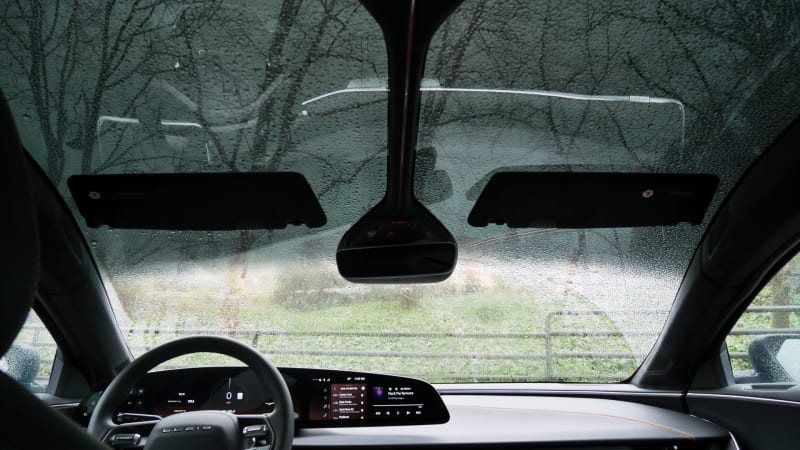
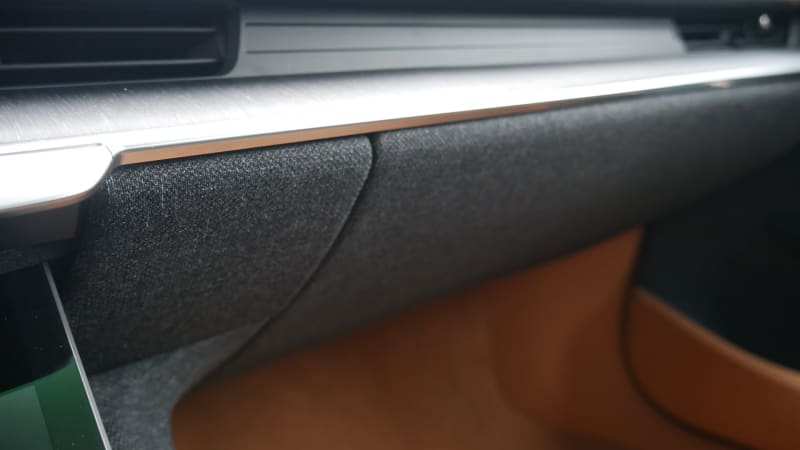
What are the Lucid Air interior and in-car technology like?
For a car that starts at nearly $90,000, you’d hope a luxury car would have a special interior, and the Lucid Air does not disappoint. Materials and build quality have been excellent in the three test cars we’ve sampled, and we very much appreciated the three design motifs inspired by different places in California (though we worry about the light-colored carpets). There are also several ambient lighting programs, but they are subtle, unlike the disco going on inside a Mercedes EQS.
The design is clean and modern, yet there are still physical buttons for the climate controls, window switches, gear selector and turn signals. Much of the car’s functions are operated through touchscreen controls, but rather than one jumbo screen as in most cars today, the Lucid splits functions between two interconnected screens integrated beautifully into the dash (rather than just bolting a big TV to the dash). A third touchscreen that controls lights and windshield wipers is located about where they’ve historically been, to the left side of the steering wheel.
It’s a system that generally makes sense once you clue into the two center screens being connected, and Lucid has already released over-the-air updates for functionality improvements, so what we’ve experienced thus far isn’t necessarily permanent. That’s a good thing, because we experienced some glitches in the software that hopefully will be addressed with future updates, though none were serious.
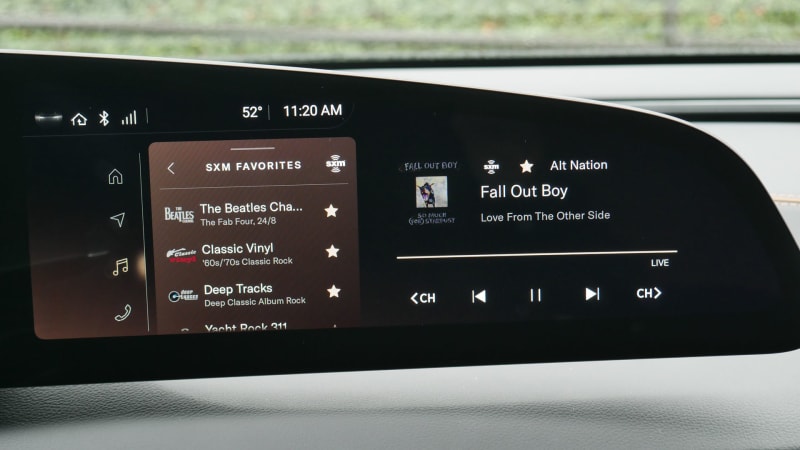
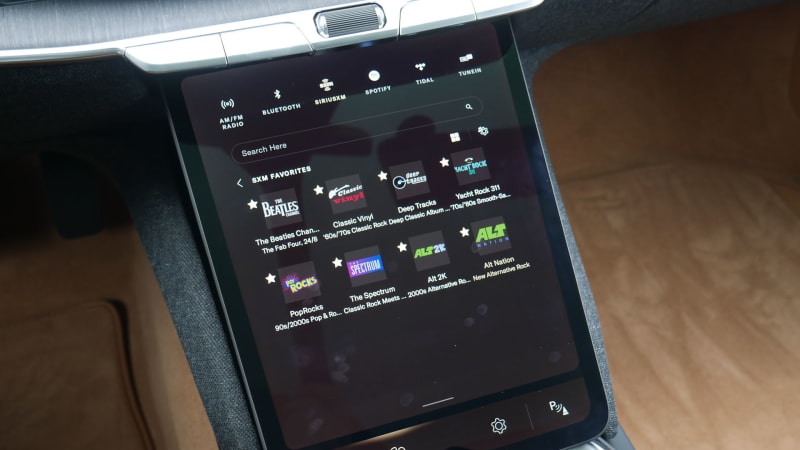
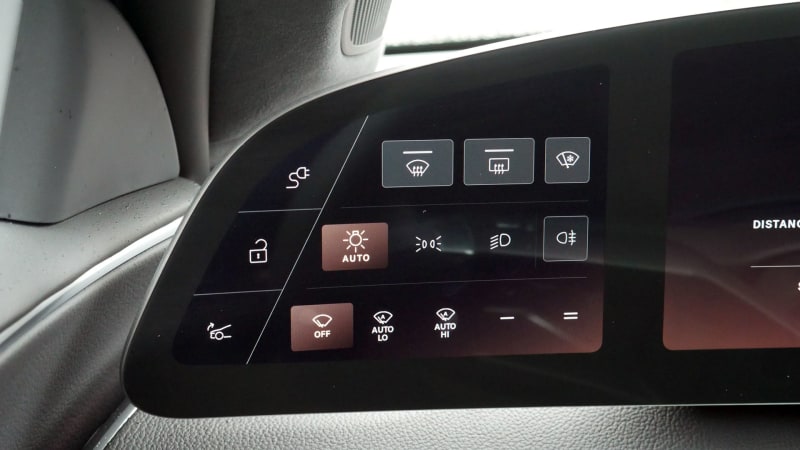
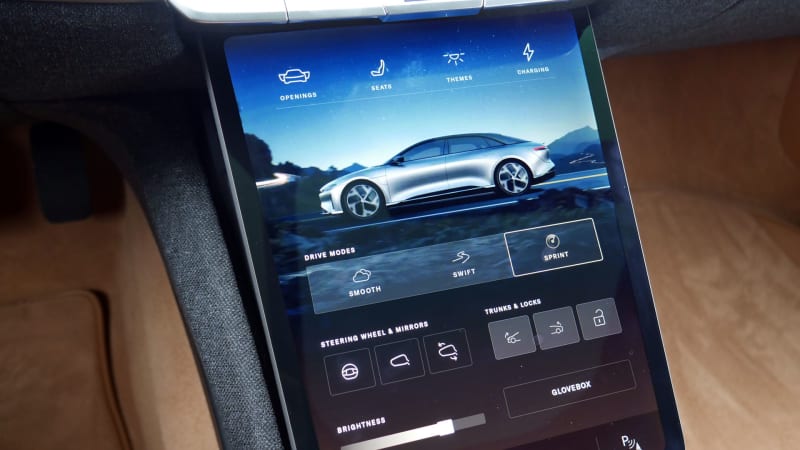
How big is the Lucid Air?
This is a big, full-size luxury sedan. However, because of unique packaging advantages of the Lucid’s compact motors and EVs in general, it’s even bigger inside than you might expect. Back seat legroom can be immense, and headroom is more generous than in a Mercedes EQS. We said “can be” because the Grand Touring’s extra battery packs basically fill the backseat footwell. This raises the floor, which leaves backseat occupants’ feet awfully close to the same level as their butts. It’s like sitting in an SUV’s third row, albeit with the front seats ahead miles away. We’d also caution against the $4,000 “Glass Canopy” roof, as the tinting starts too low on the windshield, and there’s no shade to fully block the sun. You shouldn’t need to wear a hat while driving a sedan.
Cargo space is unique, to say the least. The trunk lid is like a great big clamshell on the back of the car that opens to reveal an unusual slot-like space that’s shorter in height than the typical trunk. A lot of bags won’t be able to sit on their sides. Literally dig deeper, though, and you’ll find a huge under-floor compartment big enough to hold a roll-aboard suitcase with room left over. There is then a similarly unique frunk, accessed by the power-operated hood. It first appears to be a wide, shallow space, but it too has a deep under-floor area that when the floor is removed allows for two roll-aboards.
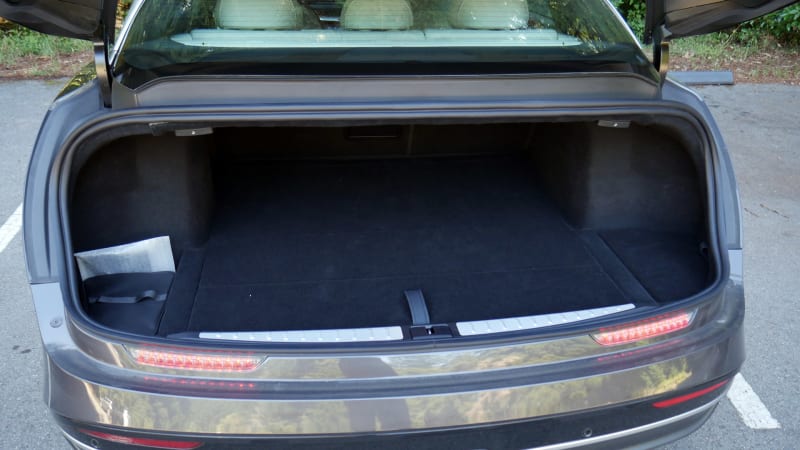
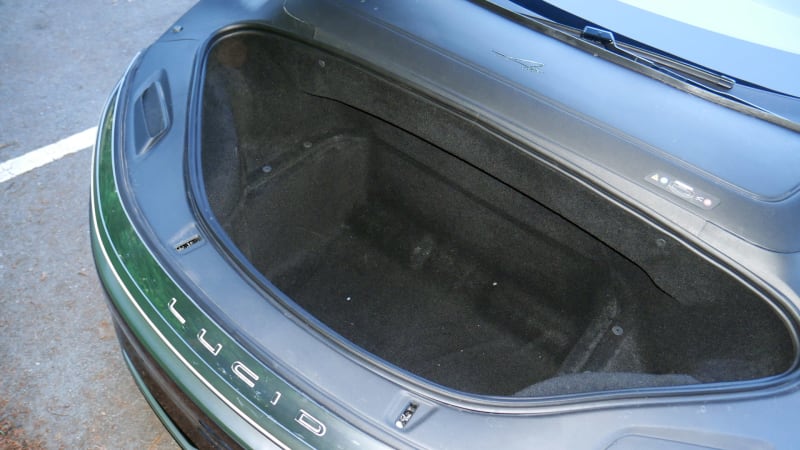
What are the Lucid Air’s range and performance specs?
At the time of this writing, full specs for the base Lucid Air Pure were not available. That will have a single rear motor, but that’s basically all we know about it.
The Pure AWD (pictured below) has two motors that together produce 480 horsepower with an estimated 0-60 time of 3.8 seconds. That’s insanely quick despite there being at least four performance levels beyond it. EPA-estimated range is 410 miles. Its maximum DC fast-charging rate is 250 kilowatts, which is extremely rapid (few are better), theoretically recouping 200 miles of range in only 15 minutes. The max AC home charging rate of every Lucid is 19.2 kW, which greatly exceeds the capabilities of the typical home charger. The Air can also power your home or recharge another electric car.
The Touring’s two motors produce a combined 620 hp, and Lucid says it’ll hit 60 in 3.4 seconds. At this point, we should mention that 0-60 times really don’t properly convey the amount of acceleration on tap with these absurd power levels. Ultimately, they are limited by the traction provided by tires. The Touring has the least amount of range among Air models, with either 425 miles (19-inch wheels) or 384 miles (20- and 21-inch wheels). Its maximum DC fast-charging rate is also 250 kW.
The Grand Touring produces 819 hp and hits 60 in 3 seconds. Crucially, it also adds four battery packs that increase range to 516 miles with 19-inch wheels, and 469 miles with 20- or 21-inch wheels. The downside of those extra packs is described in the section above. Maximum DC fast charging goes up to 300 kW, and theoretically allowing you to recoup 200 miles in 12 minutes.
The Grand Touring Performance produces 1,050 hp and can hit 60 mph in 2.6 seconds. Range stands at 446 miles since the 21-inch wheels are standard. It has the same fast-charging rate.
Finally, the Lucid Air Sapphire produces “1,200-horsepower plus” and has a 0-60 time of “under 2 seconds.” Range was still to be determined at the time of this writing. It has the same 300 kW fast-charging rate.
What’s the Lucid Air like to drive?
Yes, it is fast. And when you engage the “Sprint” driving mode (after agreeing that you acknowledge the inherent risks of doing so), it becomes snap-your-head-back, holy-cow, laugh-out-loud quick. And that’s just the Touring model. The Grand Touring, Grand Touring Performance and Sapphire just get nuttier.
It’s the rest of the driving experience that’s ultimately more important, though, and the Air delivers in droves with a beautifully damped ride that strikes a just-right balance between comfort and response. The steering is precise, though Lucid’s claims that it benchmarked a 911 GT3 and E39 BMW M5 make it sound a lot better than it is. This is a big car with terrific handling for a big car, but we wouldn’t venture to call it a sport sedan, and that’s totally OK. One of the great things about the Lucid Air is how authentic it feels, as in it’s not trying to emulate another car brand. It feels like its own thing, for the better.
What other Lucid Air reviews can I read?
Lucid Air First Drive Review: New kid in town beats everyone up
This is our review of the Grand Touring and Grand Touring Performance, specifically, but features in-depth information about its engineering and design.
Why the Lucid Air is more than the sum of its eye-popping specs
A deeper dive into the Lucid’s engineering, design, software and interior. You’ll want to read this so you’ll have lots to gush about to your friends. (Also, can you spot Top Gear’s original Stig, Ben Collins, in the below photo?)
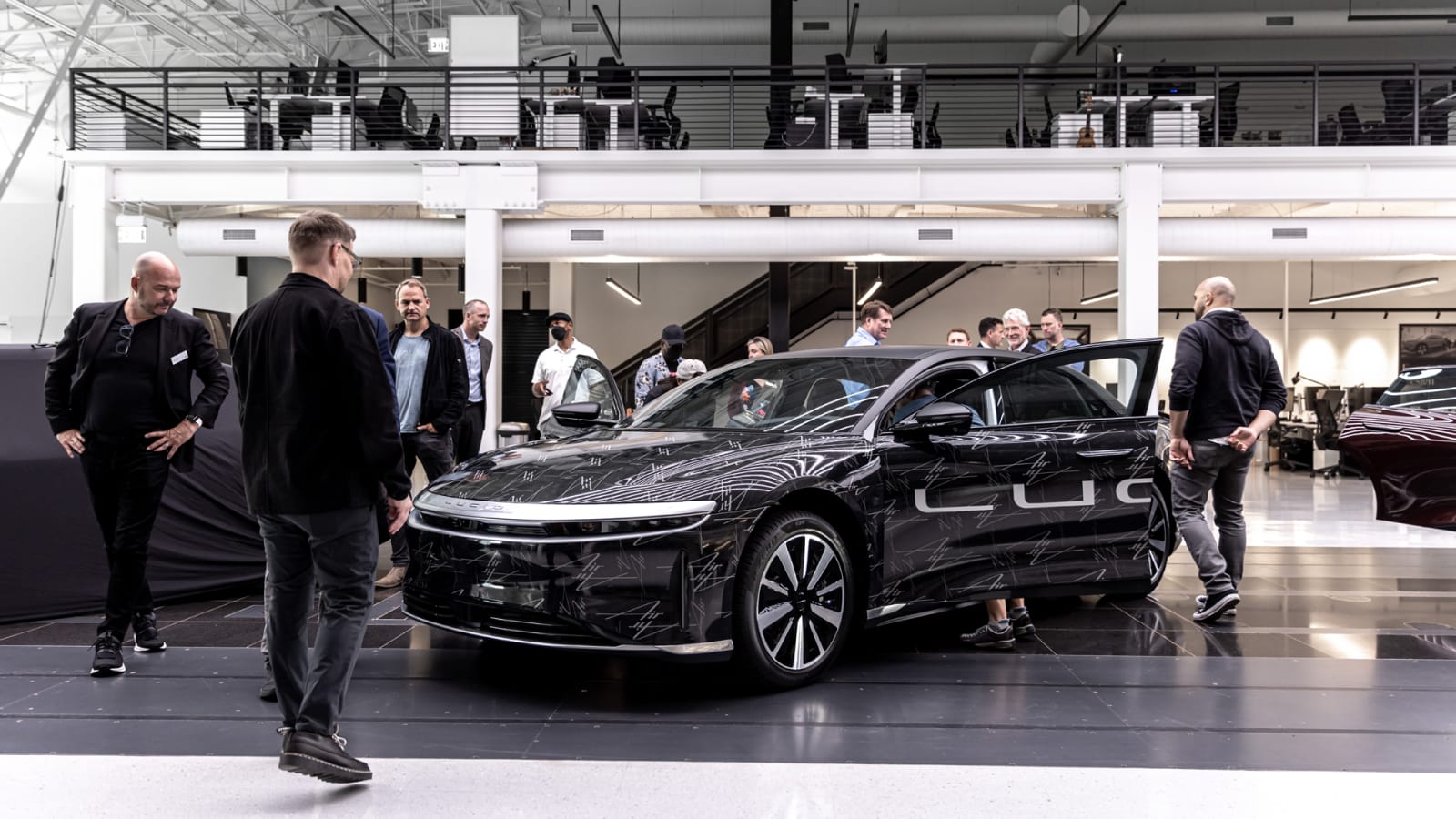
What is the Lucid Air price?
The Lucid Air is purchased online, so really, your best bet for the latest pricing and options is on the company website where you can build the car and reserve one. You can also buy already-built cars.
Pricing for each model is indicated below (as of March 22, 2023), including the $1,650 destination charge.
Pure: $89,050
Pure Dual Motor: $94,550
Touring: $109,050
Grand Touring: $139,650
Grand Touring Performance: $180,650
Sapphire: $250,650
You can read more about what you get with the Air Sapphire here. It is pictured below.
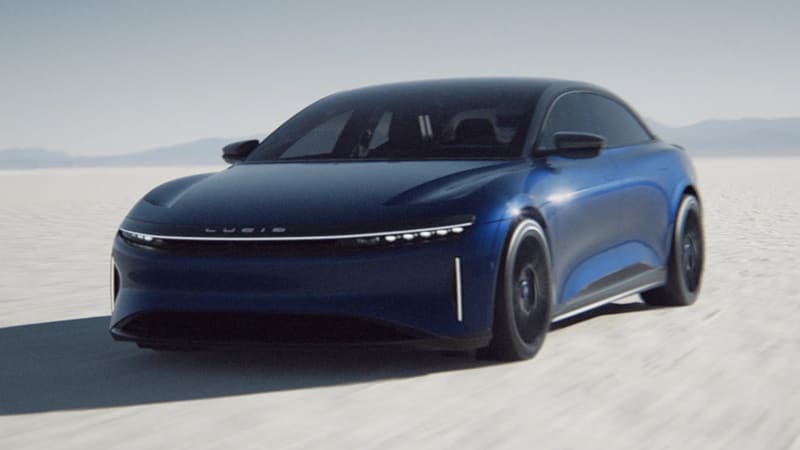
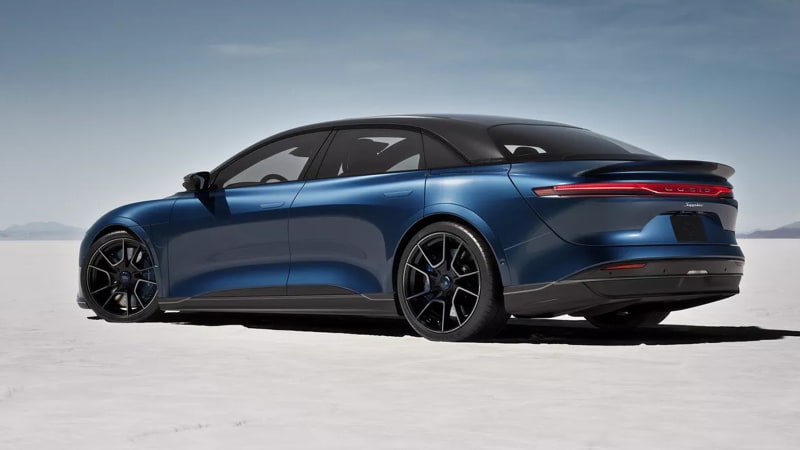
What are the Lucid Air safety ratings and driver assistance features?
Every Lucid Air includes the DreamDrive suite of driver assistance systems. This includes forward collision warning, front and rear automatic emergency braking, front and rear cross-traffic warning, blind-spot warning, lane-departure warning, automated parking control (parallel and perpendicular), parking sensors, driver inattention warning and adaptive cruise control. The DreamDrive Pro system ($10,000!) includes a surround-view parking camera system, a blind-spot camera that displays in the instrument panel, lane-centering steering assist for the adaptive cruise control, and most notably, future-ready hardware for an enhanced adaptive cruise control system that will allow for hands-free driving. Vehicle sensors also get an upgrade. It’s common for lane-centering assist to just be included with adaptive cruise control these days, so it’s disappointing you have to pay so much to get it and wait for an even more advanced system that’ll arrive TBD.
The Air has not been crash tested by a third party.


